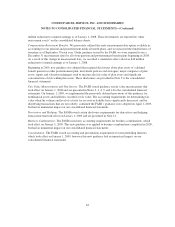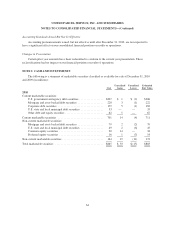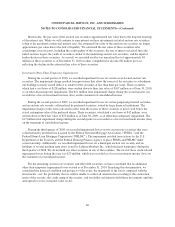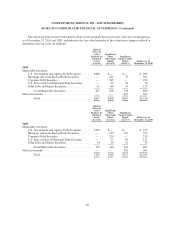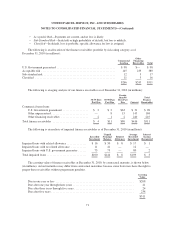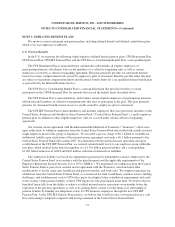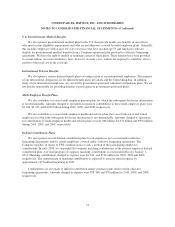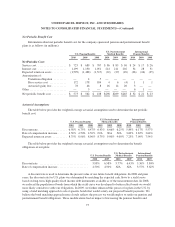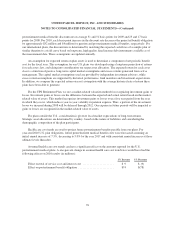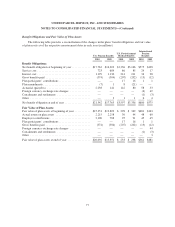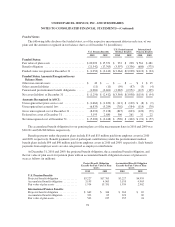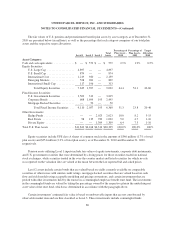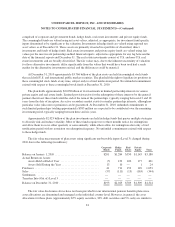UPS 2010 Annual Report Download - page 85
Download and view the complete annual report
Please find page 85 of the 2010 UPS annual report below. You can navigate through the pages in the report by either clicking on the pages listed below, or by using the keyword search tool below to find specific information within the annual report.UNITED PARCEL SERVICE, INC. AND SUBSIDIARIES
NOTES TO CONSOLIDATED FINANCIAL STATEMENTS—(Continued)
NOTE 5. EMPLOYEE BENEFIT PLANS
We sponsor various retirement and pension plans, including defined benefit and defined contribution plans
which cover our employees worldwide.
U.S. Pension Benefits
In the U.S. we maintain the following single-employer defined benefit pension plans: UPS Retirement Plan,
UPS Pension Plan, UPS IBT Pension Plan, and the UPS Excess Coordinating Benefit Plan, a non-qualified plan.
The UPS Retirement Plan is noncontributory and includes substantially all eligible employees of
participating domestic subsidiaries who are not members of a collective bargaining unit, as well as certain
employees covered by a collective bargaining agreement. This plan generally provides for retirement benefits
based on average compensation levels earned by employees prior to retirement. Benefits payable under this plan
are subject to maximum compensation limits and the annual benefit limits for a tax qualified defined benefit plan
as prescribed by the Internal Revenue Service.
The UPS Excess Coordinating Benefit Plan is a non-qualified plan that provides benefits to certain
participants in the UPS Retirement Plan for amounts that exceed the benefit limits described above.
The UPS Pension Plan is noncontributory and includes certain eligible employees of participating domestic
subsidiaries and members of collective bargaining units that elect to participate in the plan. This plan generally
provides for retirement benefits based on service credits earned by employees prior to retirement.
The UPS IBT Pension Plan is noncontributory and includes employees that were previously members of the
Central States, Southeast and Southwest Areas Pension Fund (“Central States Pension Fund”), a multi-employer
pension plan, in addition to other eligible employees who are covered under certain collective bargaining
agreements.
Our national master agreement with the International Brotherhood of Teamsters (“Teamsters”) allowed us,
upon ratification, to withdraw employees from the Central States Pension Fund and establish this jointly trusteed
single-employer plan for this group of employees. We recorded a pre-tax charge of $6.1 billion to establish our
withdrawal liability upon ratification of the national master agreement, and made a $6.1 billion payment to the
Central States Pension Fund in December 2007. In connection with the national master agreement and upon
establishment of the UPS IBT Pension Plan, we restored certain benefit levels to our employee group within the
new plan, which resulted in the initial recognition of a $1.701 billion pension liability and a corresponding
$1.062 billion reduction of AOCI and $639 million reduction of deferred tax liabilities.
The withdrawal liability was based on computations performed by independent actuaries employed by the
Central States Pension Fund, in accordance with the plan document and the applicable requirements of the
Employee Retirement Income Security Act of 1974 (“ERISA”). We negotiated our withdrawal from the Central
States Pension Fund as part of our national master agreement with the Teamsters, which included other
modifications to hourly wage rates, healthcare and pension benefits, and work rules. We sought to negotiate our
withdrawal from the Central States Pension Fund, as we believed the fund would likely continue to have funding
challenges, and would present a risk to UPS of having to face higher future contribution requirements and a risk
to the security of the pension benefits of those UPS employees who participated in the fund. We believe that we
benefited financially from the ability to achieve a ratified national master agreement seven months before the
expiration of the previous agreement, as well as by gaining better control over the future cost and funding of
pension benefits by limiting our obligations solely to UPS Teamster employees through the new UPS IBT
Pension Plan. As the UPS IBT Pension Plan matures, we believe that it will become cost beneficial from a cash
flow and earnings standpoint compared with having remained in the Central States Pension Fund.
73


